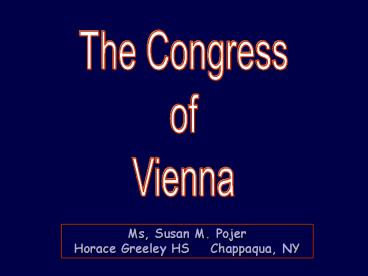The Congress of Vienna - PowerPoint PPT Presentation
1 / 17
Title:
The Congress of Vienna
Description:
Title: The Congress of Vienna Author: Ms. Susan M. Pojer Last modified by: Jeff Burns Created Date: 1/13/2006 2:51:26 PM Document presentation format – PowerPoint PPT presentation
Number of Views:168
Avg rating:3.0/5.0
Title: The Congress of Vienna
1
The Congress of Vienna
Ms, Susan M. PojerHorace Greeley HS
Chappaqua, NY
2
Europe in 1812
3
The Congress of Vienna(September 1, 1814 June
9, 1815)
4
Coin Commemorating the Opening of the Congress of
Vienna
5
Main Objectives
- Its job was to undo everything that Napoléon had
done - Reduce France to its old boundaries ? her
frontiers were pushed back to 1790 level. - Restore as many of the old monarchies as possible
that had lost their thrones during the Napoléonic
era. - Supported the resolution There is always an
alternative to conflict.
6
Key Players at Vienna
Foreign Minister, Viscount Castlereagh (Br.)
Tsar Alexander I (Rus.)
The HostPrince Klemens von Metternich (Aus.)
King Frederick William III (Prus.)
Foreign Minister, Charles Maurice de Tallyrand
(Fr.)
7
Key Principles Established at Vienna
- Balance of Power
- Legitimacy
- Compensation
- Coalition forces would occupy France for 3-5
years. - France would have to pay an indemnity of
700,000,000 francs.
8
Changes Made at Vienna (1)
- France was deprived of all territory conquered
by Napoléon. - Russia was given most of Duchy of Warsaw
(Poland). - Prussia was given half of Saxony, parts of
Poland, and other German territories. - A Germanic Confederation of 30 states (including
Prussia) was created from the previous 300, under
Austrian rule. - Austria was given back territory it had lost
recently, plus more in Germany and Italy. - The House of Orange was given the Dutch Republic
and the Austrian Netherlands to rule.
9
The Germanic Confederation, 1815
10
Changes Made at Vienna (2)
- Norway and Sweden were joined.
- The neutrality of Switzerland was guaranteed.
- Hanover was enlarged, and made a kingdom.
- Britain was given Cape Colony, South Africa, and
various other colonies in Africa and Asia. - Sardinia was given Piedmont, Nice, Savoy, and
Genoa. - The Bourbon Ferdinand I was restored in the Two
Sicilies. - The Duchy of Parma was given to Marie Louise.
- The slave trade was condemned (at British
urging). - Freedom of navigation was guaranteed for many
rivers.
11
Europe After the Congress of Vienna
12
What was the legacy of the Congress of Vienna?
13
- The Congress of Vienna was a victory for
conservatives. Kings and princes resumed power in
country after country, in keeping with
Metternichs goals. Nevertheless, there were
important differences from one country to
another. Britain and France now had
constitutional monarchies. Generally speaking,
however, the governments in Eastern and Central
Europe were more conservative. The rulers of
Russia, Prussia, and Austria were absolute
monarchs.
14
- Late in 1815, Czar Alexander I, Emperor Francis
I of Austria, and King Frederick William III of
Prussia signed an agreement called the Holy
Alliance. In it, they pledged to base their
relations with other nations on Christian
principles in order to combat the forces of
revolution. Finally, a series of alliances
devised by Metternich, called the Concert of
Europe, ensured that nations would help one
another if any revolutions broke out.
15
- France after 1815 was deeply divided
politically. Conservatives were happy with the
monarchy of Louis XVIII and were determined to
make it last. Liberals, however, wanted the king
to share more power with the legislature. And
many people in the lower classes remained
committed to the ideals of liberty, equality, and
fraternity. Similarly, in other countries there
was an explosive mixture of ideas and factions
that would contribute directly to revolutions in
1830 and 1848.
16
- Revolution in Latin America The actions of the
Congress of Vienna had consequences far beyond
events in Europe. When Napoleon deposed the king
of Spain during the Peninsular War, liberal
Creoles (colonists born in Spanish America)
seized control of many colonies in the Americas.
When the Congress of Vienna restored the king to
the Spanish throne, royalist peninsulares
(colonists born in Spain) tried to regain control
of these colonial governments. The Creoles,
however, attempted to retain and expand their
power. In response, the Spanish king took steps
to tighten control over the American colonies. - This action angered the Mexicans, who rose in
revolt and successfully threw off Spains
control. Other Spanish colonies in Latin America
also claimed independence. At about the same
time, Brazil declared independence from Portugal.
17
- Long-Term Legacy The continent-wide efforts to
establish and maintain a balance of power
diminished the size and the power of France. At
the same time, the power of Britain and Prussia
increased. - Nationalism began to spread in Italy, Germany,
Greece, and to other areas that the Congress had
put under foreign control. European colonies
also responded to the power shift. Spanish
colonies took advantage of the events in Europe
to declare their independence and break away from
Spain. - At the same time, ideas about the basis of power
and authority had changed permanently as a result
of the French Revolution. More and more, people
saw democracy as the best way to ensure equality
and justice for all. The French Revolution, then,
changed the social attitudes and assumptions that
had dominated Europe for centuries. A new era had
begun.































